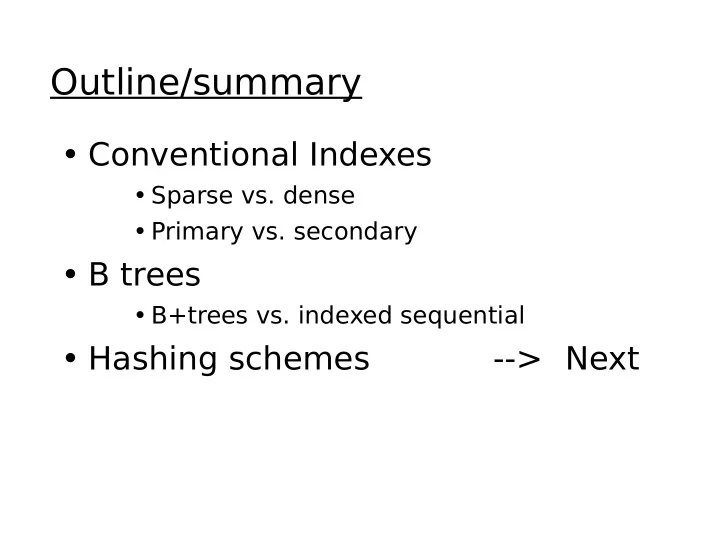

Outline/summary • Conventional Indexes • Sparse vs. dense • Primary vs. secondary • B trees • B+trees vs. indexed sequential • Hashing schemes --> Next
Hashing <key> key → h(key) Buckets (typically 1 . disk block) . .
T wo alternatives . . . records (1) key → h(key) . . .
T wo alternatives record (2) key → h(key) key 1 Index • Alt (2) for “secondary” search key
Example hash function • Key = ‘x 1 x 2 … x n ’ n byte character string • Have b buckets • h: add x 1 + x 2 + ….. x n – compute sum modulo b
This may not be best function … Read Knuth Vol. 3 if you really need to select a good function. Good hash function: Expected number of keys/bucket is the same for all buckets
Within a bucket: • Do we keep keys sorted? • Yes, if CPU time critical & Inserts/Deletes not too frequent
Next: example to illustrate inserts, overfmows, deletes h(K)
EXAMPLE 2 records/bucket 0 INSERT: d h(a) = 1 1 a e c h(b) = 2 2 b h(c) = 1 3 h(d) = 0 h(e) = 1
EXAMPLE: deletion Delete: 0 a e 1 b d f c d c 2 e 3 f maybe move g “g” up
Rule of thumb: • T ry to keep space utilization between 50% and 80% Utilization = # keys used total # keys that fjt • If < 50%, wasting space • If > 80%, overfmows signifjcant depends on how good hash function is & on # keys/bucket
How do we cope with growth? • Overfmows and reorganizations • Dynamic hashing • Extensible • Linear
Extensible hashing: two ideas (a) Use i of b bits output by hash function b b 00110101 h(K) → i use i → grows over time….
(b) Use directory . . h(K)[ i ] to bucket . . . .
Example: h(k) is 4 bits; 2 keys/bucket i = 2 1 00 i = 1 0001 01 0 1 10 2 1 1001 11 1010 1100 New directory Insert 2 1 1100 1010
Example continued 2 0000 i = 2 0001 00 2 1 01 0111 0001 10 0111 2 11 1001 1010 Insert: 2 0111 1100 0000
Example continued i = 3 2 0000 000 0001 i = 2 001 00 2 0111 010 01 011 3 10 1001 1001 100 11 3 2 1010 1001 101 1010 Insert: 110 2 1001 1100 111
Extensible hashing: deletion • No merging of blocks • Merge blocks and cut directory if possible (Reverse insert procedure)
Deletion example: • Run thru insert example in reverse!
Extensible hashing Summary Can handle growing fjles + - with less wasted space - with no full reorganizations Indirection - (Not bad if directory in memory) Directory doubles in size - (Now it fjts, now it does not)
Linear hashing • Another dynamic hashing scheme T wo ideas: b (a) Use i low order bits of 01110101 hash grows i (b) Number of buckets in use grows linearly Constraint: 2 i-1 ≤ n+1 < 2 i (We take n to be the id of the largest bucket in use, starting at 0.)
Example b =4 bits, i =2, 2 keys/bucket • insert 0101 0101 • can have overfmow chains! Future growth 0000 0101 buckets 1010 1111 00 01 10 11 n = 01 (number of last bucket in use) Rule If h(k)[ i ] ≤ n , then look at bucket h(k)[i ] else, look at bucket h(k)[ i ] - 2 i -1
Example b =4 bits, i =2, 2 keys/bucket • insert 1110 1110 bucket h(k)[ i ] - 2 i -1 is the bucket whose ith bit is fmipped in binary Future growth 0000 0101 buckets 1010 1111 00 01 10 11 n = 01 (number of last bucket in use) Rule If h(k)[ i ] ≤ n , then look at bucket h(k)[i ] else, look at bucket h(k)[ i ] - 2 i -1
Example b =4 bits, i =2, 2 keys/bucket 0101 • insert 0101 Future growth 0000 0101 1010 1111 buckets 0101 1010 1111 00 01 10 11 n = 01 10 11 Rule If h(k)[ i ] ≤ n , then look at bucket h(k)[i ] else, look at bucket h(k)[ i ] - 2 i -1
Example Continued: How to grow beyond this? Constraint: 2 i-1 ≤ n+1 < 2 i i = 2 3 0101 0000 0101 1010 1111 0101 0101 101 100 0 00 01 10 0 0 0 11 . . . 100 101 110 111 n = 11 100 101 Rule If h(k)[ i ] ≤ n , then look at bucket h(k)[i ] else, look at bucket h(k)[ i ] - 2 i -1
When do we expand fjle? • Keep track of: # records = U # buckets • If U > threshold then increase n (and maybe i )
Linear Hashing Summary Can handle growing fjles + - with less wasted space - with no full reorganizations + No indirection like extensible hashing Can still have overfmow chains -
Example: BAD CASE Very full Very empty Need to move n here… Would waste space...
Summary Hashing - How it works - Dynamic hashing - Extensible - Linear
B+trees vs Hashing • Hashing good for probes given key e.g., SELECT … FROM R WHERE R.A = 5
B+T rees vs Hashing • INDEXING (Including B T rees) good for Range Searches: e.g., SELECT FROM R WHERE R.A > 5
Recommend
More recommend